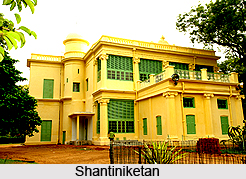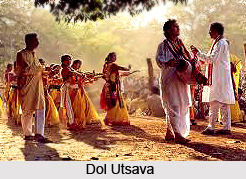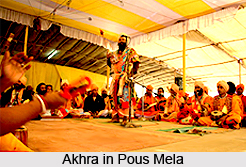 Leisure tourism in Birbhum district is an exploration into the culture and tradition of the place. There are a number of places of tourist interest located here which are an exhibition of the history and the artistic and cultural legacy of the Birbhum district as part of the state of West Bengal. Found here are a number of temples, centres of learning and art and craft centers located in Birbhum district which are a must-see when on a trip to the places. One of the most revered and much visited places of tourist interest in Birbhum district is Santiniketan, the place where Rabindranath Tagore wrote most of his literary classics, now a university town. This and the other places of leisure tourism located in the district of Birbhum are discussed below.
Leisure tourism in Birbhum district is an exploration into the culture and tradition of the place. There are a number of places of tourist interest located here which are an exhibition of the history and the artistic and cultural legacy of the Birbhum district as part of the state of West Bengal. Found here are a number of temples, centres of learning and art and craft centers located in Birbhum district which are a must-see when on a trip to the places. One of the most revered and much visited places of tourist interest in Birbhum district is Santiniketan, the place where Rabindranath Tagore wrote most of his literary classics, now a university town. This and the other places of leisure tourism located in the district of Birbhum are discussed below.
Santiniketan
Santiniketan has the distinct identity of culture and heritage, which gives the place a unique soft touch. This is a preferred tourist destination developed as a part of the popular religious-cultural tourist circuit of the region viz. Santiniketan-Bakreswar-Tarapith. The place was originally selected by Maharshi Debendranath Tagore to practice religious mediations. On an experimental basis, Rabindranath Tagore started the `Brahmacharya Ashrama` here with an objective to educate the student in close liaison with nature in the style of `Tapovana` of ancient India. Later an international university named Visva-Bharati came up as a center of Indian culture and the meeting place of the East and the West. Being a great lover of nature, Rabindranath planted trees in and around the Ashrama and gave it a green look. He introduced the celebration of a number of festivals and great names, free from any religious bindings.
The important seasonal festivals held here are as follows:
Vriksharopana and Halakarshana
These are festivals of tree planting and ploughing accompanied by music, dance and chanting of Vedic Hymns to invoke nature`s fertility and healing up of wounds of nature, held annually in the month of August.
Varshamangal
Held to celebrate the rainy season in the month of August.
Silpotshava
Held in the month of September to exhibit the handicrafts of Santiniketan-Sriniketan industries.
Pous Utsava
Held from seventh of Pous every year to commemorate the Maharshi`s initiations in to Brahmo religion and foundation day of `Brahmacharya Ashrama`. Prayer at `Chhatimtala` marks the beginning of the day. Various cultural functions are organised. Folk artists from rural Bengal, especially, bauls and fakirs, gather to sing songs for three days.
 Basantotsava: Held in the month of March on the day of Holi. Spring is welcomed through music and dances. Teachers and students greet each other with Abirs in this festival day.
Basantotsava: Held in the month of March on the day of Holi. Spring is welcomed through music and dances. Teachers and students greet each other with Abirs in this festival day.
There are a number of heritage places located here. These are:
Chhatimtala
Maharshi Debendarath used to mediate under the Chhatim Trees.
Upasana Griha
A prayer hall made of several colored Belgium glasses with marble steps on all the four sides. During evening service, candle is lit around the prayer hall, and it wears a magnificent look in the flickering light.
Dehali
Rabindranath Tagore used to live with his wife Mrinali Devi in this two storied building.
China Bhavana
A centre for Chinese studies. Natir Puja, a dance drama of Tagore is painted on its wall under the guidance of Nandalal Bose, pioneering Indian artist.
Black House
A mud building known for its relief works done by stalwarts like Ram Kinkar and Prabhas Sen.
Santiniketan Griha
The oldest building of Santiniketan.
Uttarayana
The garden with five houses where Rabindranath used to live.
 Shyamali
Shyamali
Rabindranath welcomed Mahatma Gandhi at this mud house.
Udayana
The biggest building where Rabindranath spent his last days.
Museum and Archive
Situated in Uttranyana complex, it contains the original manuscript, paintings and personal belongings of Rabindranath. Archive has a Library and research wing.
Another worth visiting place around Santiniketan is the remnants of `Khoai`- a name coined by the poet himself for a special kind of undulating laterite land formation. The stream of rainwater meandering through it offers a magnificent view during monsoon. Santiniketan is among the most visited tourist destinations, not only in the Birbhum district but in all West Bengal.
A second but contiguous campaign of Visva Bharati University came to be located in 1923 at a site which assumed the name of Sriniketan. It took over the work of training in handicrafts already began by Silpa Bhavana. But the main object was that it bringing back life in is completeness to the villages and help people to solve their own problems instead of solution being imposed on them from outside. An emphasis was laid on a scientific study of the village problem before a solution was attempted. A school was also started in Santiniketan in 1924 called "Siksha-Satra" and shifted to Sriniketan in 1927. The Loka-Siksha Samsad an organisation for the propagation of non-formal education amongst those who had no access to usual educational opportunities was started in 1936. Siksha-Charcha for training village school teachers followed next year.
Joydev-Kenduli
Joydev-Kenduli is the birthplace of the great Sanskrit poet Joydev, who flourished in 12th Century and composed the well known Geet - Govinda, a Sanskrit Lyrical poem. An annual mela is held in the Kenduli village on the last day of the Bengali month of Pous and the first 2 days of Magh. It is attended by thousands of pilgrims from all over, including the Bauls of Bengal. The latter are the followers of a philosophy that emphasises love for all human beings as the path leading to divine love. The village of Kendulli is located a few Kms west from Illambazar and about 35 Kms south of Suri. It is situated on the banks of the River Ajay. Nanoor is famous for being the birthplace of Chandidas, a famous lyric poet of the 14th century. It is located 47 Kms. from Suri and 29 Kms from Ahmadpur by road.
Hetampur
Hetampur, situated near Dubrajpur, is famous for the Rajbari, a historical heritage. It was formerly within the zamindari of the Raja Bahadur of Hetampur. Hetampur is a good site to visit for the purposes of leisure tourism. There are a good number of tanks found here surrounded by tall palm trees. Hetampur is well connected with Shiuri by bus.
These are the various places of leisure tourism located in the Birbhum district.



















